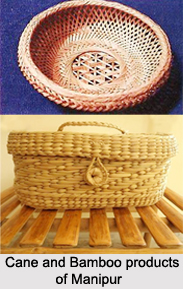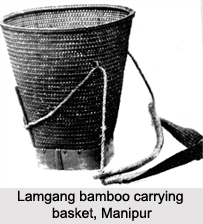 The Mongoloid culture has been described as the bamboo culture, and the northeast state of Manipur being a part of this culture, is therefore known accordingly. For the Mongoloid people, it is their slogan to eat bamboo, sleep with bamboo, live with bamboo and drink with bamboo. The case is no different in Manipur. While making crafts using bamboo, cane is also added. From time immemorial to the present day, cane and bamboo have been an integral part of the lives of the people in Manipur and the North Eastern region. The Pena singers and other bards in the valley of the state, sing even today about the multifarious uses of both cane and bamboo. However, one does not come across any specific text related to cane and bamboo among the numerous manuscripts written in the archaic Meithei script. There are mentions, though, about the way people utilised cane and bamboo in such ancient manuscripts as the Panthoibi Khonggul, the Poireiton Khunthokpa, the Phanga Chinggoirol and the Yumsharol. From the brief references, it can be inferred that measuring baskets, other type of baskets and traps were used by the people in this region, even in the period before Christ.
The Mongoloid culture has been described as the bamboo culture, and the northeast state of Manipur being a part of this culture, is therefore known accordingly. For the Mongoloid people, it is their slogan to eat bamboo, sleep with bamboo, live with bamboo and drink with bamboo. The case is no different in Manipur. While making crafts using bamboo, cane is also added. From time immemorial to the present day, cane and bamboo have been an integral part of the lives of the people in Manipur and the North Eastern region. The Pena singers and other bards in the valley of the state, sing even today about the multifarious uses of both cane and bamboo. However, one does not come across any specific text related to cane and bamboo among the numerous manuscripts written in the archaic Meithei script. There are mentions, though, about the way people utilised cane and bamboo in such ancient manuscripts as the Panthoibi Khonggul, the Poireiton Khunthokpa, the Phanga Chinggoirol and the Yumsharol. From the brief references, it can be inferred that measuring baskets, other type of baskets and traps were used by the people in this region, even in the period before Christ.
The Ningthourol Lambuba is a manuscript that chronicles the reign of the different Meithei kings, and mentions the use of a carrying basket called "Pai", by the Meitheis. These baskets were hung on the right or left shoulder to carry very light stuff. It is further stated that from about the 17th century onwards, the Pai was gradually phased out amongst the Meitheis and replaced by bags made of cloth. As such, the Meitheis today do not even use the term Pai to describe any particular type of basket. However, the tribal belts inhabiting the hills and the Lois living in places like Andro, Fayang, Laimram, Khurkhul, Sekmai, Shugnu etc. in the valley, still continue to use the terms and names of several articles that were used by the Meitheis centuries ago, with the Pai being one of them.
Col. W. McCulloch in his "Account of the Valley of Munnipore and of the Hill Tribes", gave a defined description of the houses of the Meitheis, during the 19th century, as quoted here - "The dwelling houses of the Munniporees are all of the same form, but those of the rich are larger and constructed of better materials than those of the poor, that is, the posts and beams of the former are of wood, whilst those of the later are of bamboo. The walls of both are of reeds plastered with a mixture of earth and cow dung and the roofs of all are thatched with grass."
Baskets, for example, can be stored up on Lups, which are scaffolds suspended over the fire place for some time and then preserved to last more than two generations. But people generally make and use only those things that are needed in their every day lives. Cane and bamboo articles, thus, are not easily available. The usual practice is to mend again and again even baskets that have passed through generations. Such baskets that are still in use provide the answers to several questions, such as reasons for their different makes, the methods of their make, the varied uses, the changes that had taken place and so forth.
Conical baskets, which are one of the prominent basketry products of Manipur, are still used by the hill tribes with straps, as they are handy in carrying things up and down the steep hill slopes. At one time, according to the ancient scriptures, the Meitheis residing in the valley also used conical baskets, like the Lengkot Sham, in a similar fashion. There is further evidence to the fact that the Lois living in Andro, Fayang, Laimram, Khurkhul, Sekmai etc., used conical baskets as recently as some 20 years back. The shape of such baskets underwent gradual changes when they were used by the people in the valley. They became less conical and four legs or stands were begun to be added to support the bases; loops and other projections acting as hand-hold were also added later on. In the current scenario, the Meitheis generally use baskets that are flat-bottomed and are carried on the head. Such a historical evolution of the baskets, to suit the changing environs can be understood from the physical examination of the available baskets at different places of the region today.
Another method that is used to trace the origin of the types of basketry is their nomenclature. For example, the type of traps known as "Tekhao-lu" originally came in from Assam as Tekhao is the Meithei name for Assam. Similarly, the traps coming from Kabo are known as "Kabo-lu".
The Northeast India accounts for a total of 44 species of Bamboo, out of which 15 are found in Manipur. The varieties of bamboos found in Manipur include 2 varieties of Arundinaria, 6 varieties of Bambusa, 4 varieties of Cephalostachyum and 1 variety each of Dendrocalamus, Melocalamus and Melocauna, all indigenous to the land. The Bambusa and the Cephalostachyum species grow at an elevation of 50 to 500 metres above sea level. The latter can also grow at a higher altitude. The Arundinaria varieties grow at a height of 800 to 3500 metres. Neat bamboo groves are cultivated both in the hills and in the valley of Manipur.
Keeping in tune with the different varieties of bamboo, the craftsmen make several articles and implements, for mostly utilitarian purpose, using different techniques and varied forms. In addition to the bamboo, cane is also used in making household and other utility items. In Manipur, cane is found in the Tamenglong and the Churachandpur districts, growing in abundance in rivulets and along the banks of the Barak River. Cane is also available in lesser quantity in the other hill districts of the state.
The cultural life of the people living in the valley and in the hills of Manipur cannot be imagined without bamboos and their products. The Bamboo plants are closely related to a person"s life, and in one way or the other, even to death. There is no end to the uses and utility of bamboo. The Meitheis, living in the valley distinguish particular varieties of bamboo pertaining to their different uses - bamboo for use in rituals, bamboo for use in the daily lives of people, bamboo for burning scrap and the like and so on. The variety of bamboo that has no practical use is traditionally kept out of the society from amongst the pack of usable bamboo. One of such varieties is the Wareng variety, growing out of the fruits that fall to the ground from the Utang bamboo plant (Bambusa pallid).
In Manipur, it is believed that a family living in a house built without any bamboo can never be a happy one. For the Meitheis, if one is to start a home then there should be a bamboo grove growing on their plot of land. The growth of a bamboo grove is believed to foretell the fortune of a family and for this reason, they are planted by the elders of the family and never by the youths. It is believed that if a youth plants a bamboo seedling, his life span will be curtailed. Again, it is believed that a bamboo flower growing on the grove is a bad omen for the head of the family owning that particular grove. This is perhaps because it is said that bamboo flower increases the fertility of rats, thus increasing their population, which ultimately leads to famine. For the villagers of Laimram, however, the flowering of bamboo is believed to bring good fortune if proper rituals are performed. Naturally enough, the villagers clamour for flowers and when a bamboo grove flowers, some people take a portion of that bamboo and put it in the curry that is being prepared for the family`s meal. This is again believed to bring good fortune to the person eating the food.
Related Articles:
Bamboo, Indian Plant
Bamboo Crafts in India
Bamboo and Cane Crafts of Manipur
Manipur
Crafts of Manipur
Meithei Language
Tribes of Manipur
Baskets


